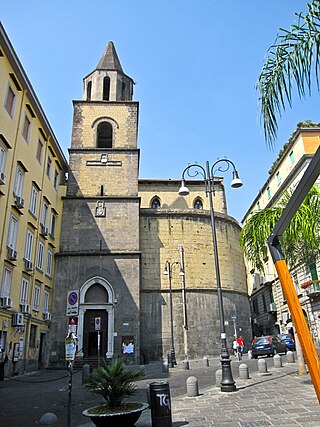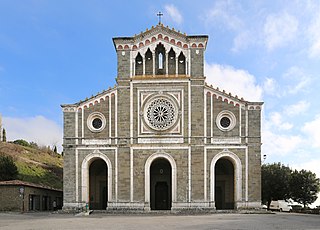
San Pietro Martire or St Peter Martyr is a Gothic architecture, Roman Catholic church, linked at one time to an adjacent Dominican convent in Vigevano, Province of Pavia, region of Lombardy, Italy.

San Pietro Martire or St Peter Martyr is a Gothic architecture, Roman Catholic church, linked at one time to an adjacent Dominican convent in Vigevano, Province of Pavia, region of Lombardy, Italy.
The date of construction is unclear. It is supposed to have been built between 1218 and 1220, where there was a chapel dedicated to Saint Dominic, subsequently replaced by a much larger building, completed no earlier than 1363 [1] and attributed to Bartolino da Novara. In 1446, the Dominican order took possession and under the patronage of Filippo Maria Visconti enlarged the church, converting the old nave into transept.<ref=alessandrocolombo>Il Rosario, Volume 22, Il Convento e la Chiesa dei Domenicani in Vigevano, by Professor Alessandro Colombo, Page 18.</ref>
The church is dedicated to Saint Peter Martyr with the adjoining convent of the friars Domenicans as attested by the pantifical bull preserved in the historical archives of Vigevano, it was consecrated in 1480. In pure Lombard Gothic style with bell tower with an octagonal base, it has a Latin cross imperfect with polystyle pillars, ending with a high polygonal choir with a crypt underneath whose access is given by two entrances on the sides of the raised presbytery. The nave has pilasters leading to gothic tracery. The interior has a number of decaying 16th-century frescoes. The chapels on the right are dedicated to St Cristopher (patron of one of the two parishes in Vigevano), St Anthony of Padua, St Vincent Ferrer, the Trinity, and the Crucifixion. On the left, they are dedicated to St Peter Martyr, St Joseph, St Dominic, St Pius V, and the Virgin of the Mercies. The altarpieces in the chapels are also by unknown artists. [2] The body of the blessed Matteo Carreri, patron saint of Vigevano, who lived and died (1470) in the adjacent convent, is preserved in the crypt. [3]

In 1645, during the French siege of Rocca Nuova, the bell tower was demolished in half, vertically, to then be recomposed a few years later. The façade, divided into three parts corresponding to the naves and surmounted in the central part by three pinnacles, has a Gothic portal with rings enclosed by a terracotta frame with a bas-relief placed in 1969. On the left side a staircase leads to the secondary entrance at the head of the transept, while in correspondence with the nave there is the trace of a portal, now walled up, similar to the one on the facade which, according to local tradition, was reserved for the Sforza court. Until the end of the nineteenth century along the left side there was an embankment that connected the level of the square in front with the side entrance.
In 1840 a construction of the false vaults, in neo-Gothic style, led to the modification of the internal appearance. The vaults, built detached from the original exposed trussed roof, have effectively hidden the frescoes of 1447-50 located in the upper part of the transept arch. These frescoes, located in the space between the vaults and the roof, depict the bust of Saint Dominic of Guzmán in the centre, on the left a landscape with a castle and a church and on the right various soldiers with spears and flags including a cartouche with the writing "britanii"; the frescoes represent an ex-voto made by the people of Vigevano for the threat of raids by mercenaries in disarray after the dissolution of the Visconti duchy whose passage was prevented by the exceptional flood of the Ticino.

Santa Maria Novella is a church in Florence, Italy, situated opposite, and lending its name to, the city's main railway station. Chronologically, it is the first great basilica in Florence, and is the city's principal Dominican church.

Santa Maria sopra Minerva is one of the major churches of the Order of Preachers in Rome, Italy. The church's name derives from the fact that the first Christian church structure on the site was built directly over the ruins or foundations of a temple dedicated to the Egyptian goddess Isis, which had been erroneously ascribed to the Greco-Roman goddess Minerva.

The Church of the Gesù is the mother church of the Society of Jesus (Jesuits), a Catholic religious order. Officially named Chiesa del Santissimo Nome di Gesù all'Argentina, its façade is "the first truly baroque façade", introducing the baroque style into architecture. The church served as a model for innumerable Jesuit churches all over the world, especially in the Americas. Its paintings in the nave, crossing, and side chapels became models for Jesuit churches throughout Italy and Europe, as well as those of other orders. The Church of the Gesù is located in the Piazza del Gesù in Rome.

The Basilica of Saint Francis of Assisi is the mother church of the Roman Catholic Order of Friars Minor Conventual in Assisi, a town in the Umbria region in central Italy, where Saint Francis was born and died. It is a papal minor basilica and one of the most important places of Christian pilgrimage in Italy. With its accompanying friary, Sacro Convento, the basilica is a distinctive landmark to those approaching Assisi. It has been a UNESCO World Heritage Site since 2000.

The Basilica of San Domenico is one of the major churches in Bologna, Italy. The remains of Saint Dominic, founder of the Order of Preachers (Dominicans), are buried inside the exquisite shrine Arca di San Domenico, made by Nicola Pisano and his workshop, Arnolfo di Cambio and with later additions by Niccolò dell'Arca and the young Michelangelo.

The Iglesia conventual de San Pablo or San Pablo de Valladolid is a church and former convent, of Isabelline style, in the city of Valladolid, in Castile and León, Spain. The church was commissioned by Cardinal Juan de Torquemada between 1445 and 1468. It was subsequently extended and refurbished until 1616. Kings Philip II and Philip IV of Spain were baptized in the church, and it was visited by Napoleon. It is one of the buildings considered most emblematic of the city.

Santa Maria in Vallicella, also called Chiesa Nuova, is a church in Rome, Italy, which today faces onto the main thoroughfare of the Corso Vittorio Emanuele and the corner of Via della Chiesa Nuova. It is the principal church of the Oratorians, a religious congregation of secular priests, founded by St Philip Neri in 1561 at a time in the 16th century when the Counter Reformation saw the emergence of a number of new religious organisations such as the Society of Jesus (Jesuits), the Theatines and the Barnabites.

San Pietro a Majella is a church in Naples, Italy. The term may also refer to the adjacent Naples music conservatory, which occupies the premises of the monastery that used to form a single complex with the church.

Santi Luca e Martina is a church in Rome, Italy, situated between the Roman Forum and the Forum of Caesar and close to the Arch of Septimus Severus.

The chiesa di Sant'Anastasia, or the Basilica of Saint Anastasia is a church built by the Dominican Order in Verona, northern Italy. In Gothic style, it is the largest church in the city, located in its most ancient district, near the Ponte Pietra.

The Basilica of San Domenico, also known as Basilica Cateriniana, is a basilica church in Siena, Tuscany, Italy, one of the most important in the city. The basilica is an example of Cistercian Gothic style.

Santa Maria del Carmine is a church in Pavia, Lombardy, northern Italy, considered amongst the best examples of Lombard Gothic architecture. It was begun in 1374 by Gian Galeazzo Visconti, Duke of Milan, on a project attributed to Bernardo da Venezia. The construction followed a slow pace, and was restarted in 1432, being finished in 1461.

The Abbey of Santa Maria di Rovegnano is a Cistercian monastic complex in the comune of Milan, Lombardy, northern Italy. The borgo that has developed round the abbey was once an independent commune called Chiaravalle Milanese, now included in Milan and referred to as the Chiaravalle district.

San Pietro Martire is a Roman catholic parish church in Murano, near Venice, northern Italy.

The Abbey of Santa Giustina is a 10th-century Benedictine abbey complex located in front of the Prato della Valle in central Padua, region of Veneto, Italy. Adjacent to the former monastery is the basilica church of Santa Giustina, initially built in the 6th century, but whose present form derives from a 17th-century reconstruction.

The Basilica of San Fedele in Como is located in the city center. The present Romanesque church dates from 1120 and is dedicated to the Fidelis of Como.

Basilica of Santa Margherita is a Neo-gothic style, Roman Catholic church, located just outside the Tuscan town of Cortona, Italy, at the intersection of Via delle Santucce and Via Sant Margherita, on a hill just below the Fortezza Medicea, and dedicated to a native saint of the town, Margaret of Cortona.

The Abbey of St. Peter is a Benedictine abbey in Assisi inhabited by a small community of monks belonging to the Cassinese Congregation. The monastery has supported a hospital for the sick, an agricultural colony, and an orphanage run by the Stigmata Sisters.

Santa Caterina d'Alessandria or Saint Catherine of Alexandria is a Roman Catholic church with a main facade on Piazza Bellini, and a lateral Western facade facing the elaborate Fontana Pretoria, in the historic quarter of Kalsa in the city of Palermo, region of Sicily, Italy. In front of the main facade, across the piazza Bellini, rise the older churches of San Cataldo and Santa Maria dell'Ammiraglio, while across Piazza Pretoria is the Theatine church of San Giuseppe and the entrance to the Quattro Canti. Refurbished over the centuries, the church retains elements and decorations from the Renaissance, Baroque, and late-Baroque (Rococo) eras. This church is distinct from the Oratorio di Santa Caterina found in the Olivella neighborhood.

The church of San Francesco of Assisi is a Catholic religious building in Pavia, Lombardy, Italy.